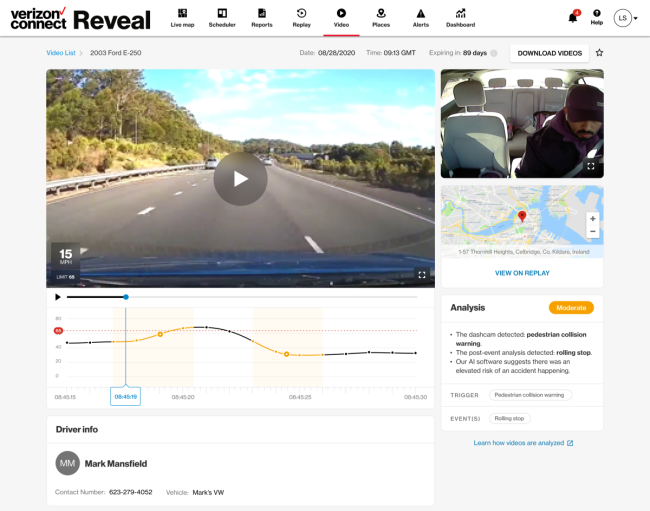
Crafting a Telematics RFP
Due to the significant financial investment, fleet managers sometimes make the mistake of basing a telematics purchasing decision on cost alone, according to Steven Berube, senior business development manager for Geotab (www.geotab.com).
“While choosing a low-cost provider may seem like an ideal choice at the time, fleet managers risk paying thousands in hidden costs associated with hardware failures or additional upgrades,” he said. “Hardware failures can result in costs associated with loss of vehicle visibility, installation fees for a replacement device and vehicle downtime. Overall, fleet managers should choose a reliable and relevant provider who helps meet their fleet goals today and in the future.”
Amin Amini, a director at Verizon Connect (www.verizonconnect.com), added, “If you’re not able to determine your return on investment in the first couple of months after the software has been installed, then something is definitely amiss, and you should discuss this with the provider you choose.”
Both Berube and Amini recently shared tips with UFP for putting together a well-thought-out telematics request for proposal (RFP) that can help reduce the stress and costs associated with switching or installing telematics devices.
Take Time to Plan
How long does it take to complete a telematics RFP? Berube encouraged fleet professionals to allow for nine to 12 months.
“The RFP must reflect the different inputs, ideas and concerns of the organization’s employees. One must consider how long it will take to realistically install new hardware or activate existing hardware if there is an OEM opportunity,” he explained.
Who should be involved in the RFP process? Include your fleet manager, IT team, operations lead, finance lead and any other people on your team who are closest to your fleet operations, Amini recommended.
He also suggested determining the fleet’s top two to three priorities.
“It’s important not to try and solve every issue or go too broad in your requirements,” Amini said. “Whether you’re focused on improving driver safety, saving money on fuel, or better serving your own end customers and improving efficiency, decide what those are before you start your RFP draft, and build your requirements and key performance indicators for the provider around those metrics and success measures.”
Once a primary plan is developed, Berube advised involving the organization’s legal, IT and security departments.
“The legal team should be engaged as early as possible as this will make the later stages of the RFP more seamless for all parties involved,” he said. “IT and security also play a pivotal role in the RFP process as they work to ensure that the data provided by the telematics provider can be integrated into other internal and external platforms, and the security of these platforms is properly vetted.”
Three Focus Areas
Security, the longevity of the product and the provider’s ability to support new technologies are three focus areas that utility fleet professionals should include in their telematics RFPs, according to Berube.
Security
“With valuable data on the line, utility professionals should prioritize acquiring a telematics solution with a comprehensive security mechanism and process that meets the highest level of security standards,” he said.
The RFP should have a dedicated section that covers cybersecurity standards, testing, data security and database management.
Berube also noted that it’s important to understand the security of the hardware provided, including who manufactures it, who can distribute firmware updates, and the level of security used to encrypt data in the device before and during cellular transmissions.
Longevity
What is the expected longevity of the company and its products? What different types of hardware are needed to support your specific fleet and equipment? For example, can the telematics provider support the adoption of different fleet models and sizes? Understanding this can help ensure the selection of a provider that meets the fleet’s needs both today and in the future, Berube said.
Support
Utility fleet professionals should also have a good grasp of the telematics provider’s dedication to innovation and understanding long-term and future trends in the connected vehicle market, he continued.
For example, does the company support OEM telematics? How committed is the telematics company to supporting new vehicle types, such as electric vehicles? The fleet professional should consider the long-term role the telematics provider will play in supporting the fleet’s current and future needs.
According to Amini, fleet management software almost always requires a customized approach.
“We have in-depth conversations with customers to understand their individual needs and goals. The size of the fleet, the number of drivers, and key areas of focus and opportunity are essential elements to fielding a successful search for a fleet management software provider,” he said.
“For example, the customer might be looking to track productivity, increase driver safety, reduce fuel costs and have a better understanding of when maintenance is required,” Amini continued. “Or they might be looking to focus on only one of those areas. Having these conversations at the beginning of the RFP process will help each provider determine the best solutions and response for the specific needs of the customer.”
Fleet management software should also be scalable to meet your needs, simple to deploy, and provide dashboards and easy-to-decipher reports that give you key insights into what’s happening with your fleet from day one, Amini said.
About the Author: Grace Suizo has been covering the automotive fleet industry since 2007. She spent six years as an editor for five fleet publications and has written more than 100 articles geared toward both commercial and public sector fleets.

